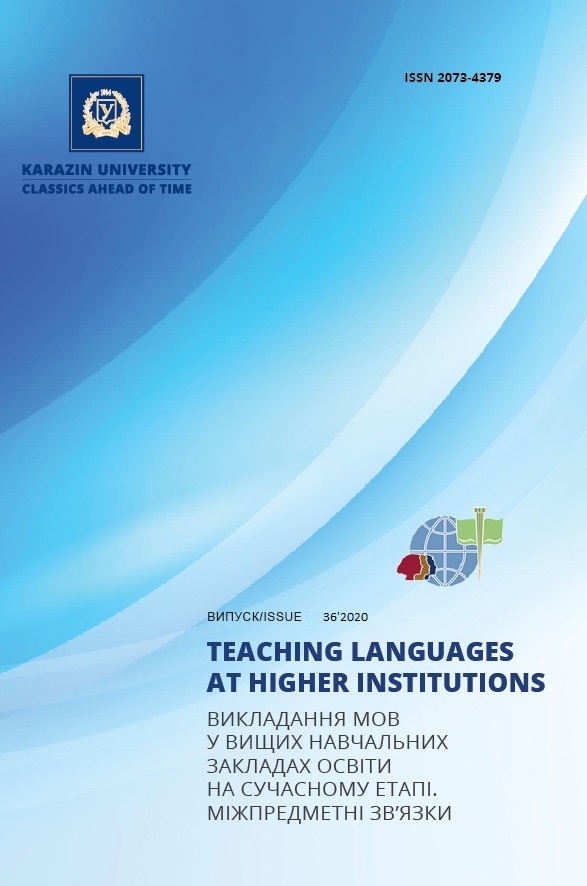Application of theory of genres in tackling professional medical discourses
Abstract
The article deals with the issues of the application of the theory of genres while handling professional medical discourses. The practical implementation of the theory of genres in learning a professional medical discourse is one of the efficient techniques in current methodology of teaching English. The topicality of the research is determined, firstly, by the fact that different genres are commonly used in the practice of medical professional interaction and the domain of a foreign language teaching in a medical language classroom. Secondly, there is a need to outline grammar and lexical peculiarities of the genres of medical discourses and their functioning in oral and written speech. The authors study the problems of the theory of genres concerning medical discourses. The researchers characterize the main lexical and grammar peculiarities of the genre of an oral presentation of a patient’s medical history, the genre of a scientific text for the specialty “Technologies of Medical Diagnosing and Treatment”, the genre of a letter of referral to a medical specialist and reveal specific features of their functioning in oral and written speech. Linguistic analysis of a medical discourse which is focused on lexical, grammatical, functional and rhetoric peculiarities of a written or an oral discourse appears to be very fruitful allowing us to answer the questions how tests are structured and organized. Textual success often depends on the familiarity of text organization for readers of the discourse community, however small or large that community might be and students should be aware of the genre norms. Dealing with professional medical genres, we assume that every genre is clearly structured and has its own sets of language structures. The task of language instructors is to acquaint the learners with existing genre norms. The authors have singled out the “moves” of the three genres and developed the sequence of pre-reading, while-reading, post-reading and information gap activities which are effective while working on the discourses that have been studied.
Downloads
References
Bailey, K.M. (2005). Practical English Language Teaching: Speaking. Mc Graw – Hill [in English].
Bhatia, V.K. (1993). Analyzing Genre: language use in professional settings. London: Longman [in English].
Bhatia, V.K. (1997). Genre Analysis and World Englishes. World Englishes. Blackwell Publishers. Volume 16, Issue 3, pp. 313–319 [in English].
Bhatia, V.K. (1997). Genre Analysis Today. Revue belge de Philologie et d’Histoire. 75–3, pp. 629–652 [in English].
Bhatia, V.K. (1997). Genre – Mixing in Academic Introductions. English for Specific Purposes. Volume 16, Issue 3, pp. 181–195 [in English]. DOI: https://doi.org/10.1016/S0889-4906(96)00039-7.
Bhatia, V.K. (1998). Generic Patterns in Fundraising Discourse. New Directions for Philanthropic Fundraising. 22, pp. 95–110 [in English].
Bhatia, V.K. (2008). Towards Critical Genre Analysis. Advances in Discourse Studies. Psychology press. 3 / 10, pp. 150−186 [in English].
Duddley-Evans, T. and Saint John, M.J. (1998). Developments in English for Specific Purposes: a multi-disciplinary approach. Cambridge: Cambridge University Press [in English].
Glendinning, E.H. (2015). English in Medicine. Cambridge: Cambridge University Press [in English].
Grice, T. (2018). Oxford English for Careers. Nursing 2. Student’s Book. Oxford: Oxford University Press [in English].
Harmer, J. (2007). The Practice of English Language Teaching. Fourth edition. Harlow: Pearson Education Limited [in English].
Mamone, L., Jones, J. and Shiguang, L. (2018). Multiple Myeloma: The Case of the Disappearing Band. Laboratory Medicine. Volume 49, Issue 1, February 2018, pp. 87–91. Available at: https://academic.oup.com/labmed/ pages/selected_case_studies_2018 [Accessed 12 Dec. 2019] [in English]. DOI: https://doi.org/10.1093/labmed/lmx045.
Nagy, W.E. (2003). Teaching Vocabulary to Improve Reading Comprehension. Newark: International Reading Association [in English].
Swales, J.M. (1990). Genre Analysis: English in academic and research settings. Cambridge: Cambridge University Press [in English].
Swales, J. (1981). Aspects of Article Introductions. Aston ESP Research Report No 1. Language Studies Unit. Birmingham: University of Astonin [in English].
Swales, J.M., Feak, C.B. (2004). Academic Writing for Graduate Students: Essential tasks and skills. Ann Arbor: University of Michigan [in English].
Wahed, A. and Dasgupta, A. (2015). Hematology and Coagulaion. A Comprehensive Review for Board Preparation, Certification and Clinical Practice. Oxford: Elsevier Inc [in English].

